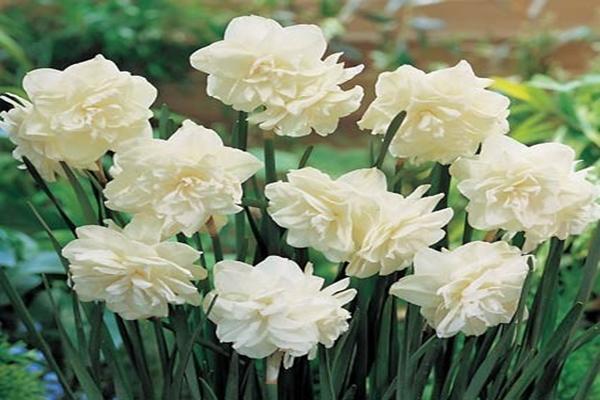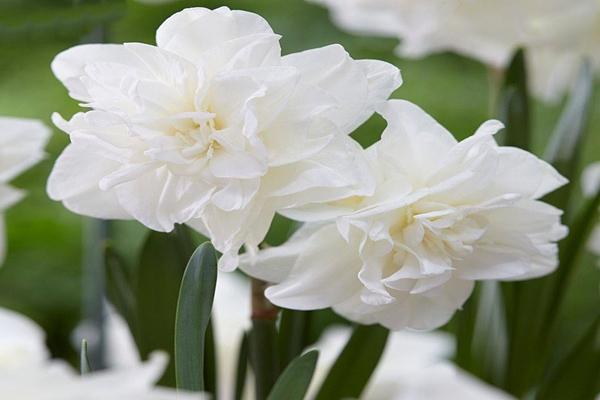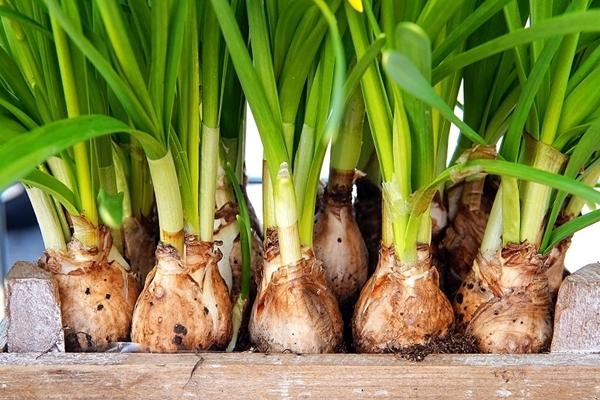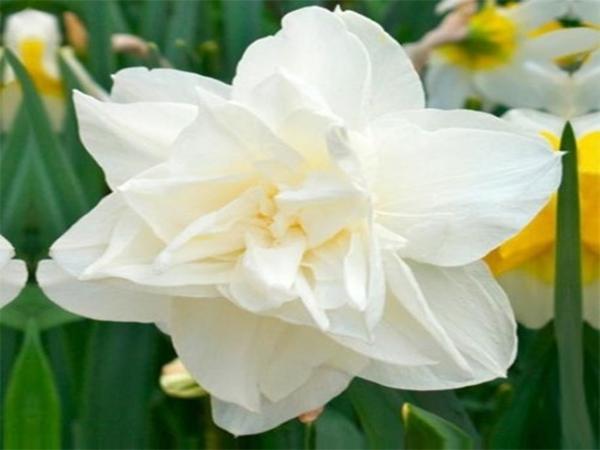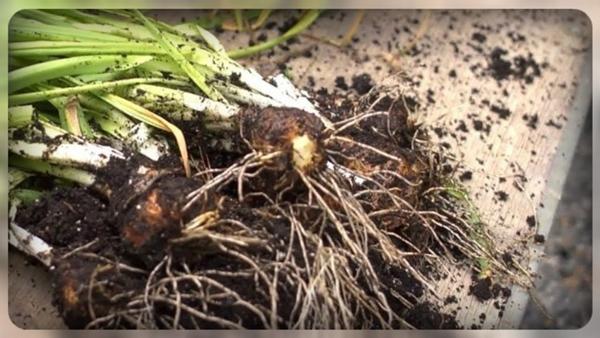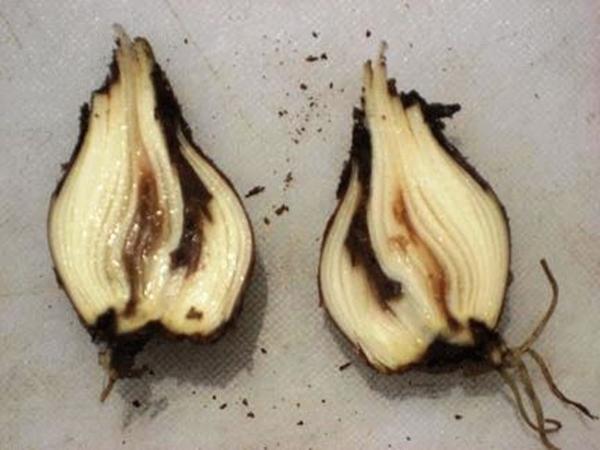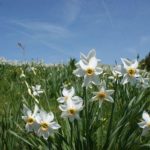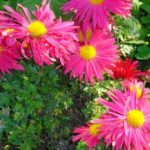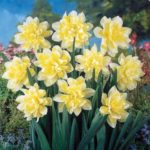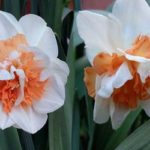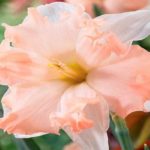Daffodils have long been adapted to the climate of mid-latitudes, although they are originally from the Mediterranean. Bulbous perennials are planted in courtyards, streets, and dachas. Among the variety of daffodil varieties, Calgary is considered one of the most beautiful flowers. The terry caps of the Amaryllis family are as bright as peonies, but are smaller in size. Bulbous perennials delight with abundant flowering in mid-spring.
- Description and characteristics of the Calgary narcissus
- Pros and cons of the variety
- The subtleties of growing a flower
- When to plant
- Preparation of seedlings and planting sites
- Landing technology
- Calgary Care Tips
- Watering and fertilizing
- Trimming
- Wintering
- Diseases and pests
- Reproduction methods
- Using daffodils in landscape design
Description and characteristics of the Calgary narcissus
The Calgary variety feels comfortable in the sun, where it blooms together, does not lose its decorative appearance in partial shade, and is distinguished by its rich color that lasts for a long time. On one peduncle of a narcissus, growing up to 40 cm in height, 2 buds are formed. The corollas consist of a large number of petals of a greenish-milky hue. The yellow stamens glow golden inside.
During flowering, which lasts up to 2 weeks, the double narcissus fills the flowerbed with a delicate aroma.
Pros and cons of the variety
The bulbous plant does not require replanting every autumn or spring; it blooms in one place for more than 5 years. The long stem allows the Calgary variety to be used for cutting and creating exquisite bouquets. Daffodils with white terry caps look graceful in a composition with thuja and coniferous shrubs. The milky flowers stand out beautifully against the dark green background.
Daffodils look impressive on the lawn, planted densely and in large numbers, harmoniously combined with red tulips, blue hyacinths, blue and purple irises.
The Calgary variety attracts designers and gardeners:
- lush flowering;
- resistance to spring frosts;
- Possibility of use for both cutting and landscaping.
Daffodils love moisture. On sandy soils, the plant needs to be watered even in spring. Calgary propagates only vegetatively; it is impossible to propagate the variety with seeds.
The subtleties of growing a flower
Daffodils take root well on a flat surface where water does not stagnate. They bloom together with crocuses and tulips, are undemanding to care, but require proper planting. Bulbs are sold in flower shops.
When purchasing, it is advised to choose solid specimens without damage or rot, measuring at least 50 mm.
When to plant
Calgary bulbs are sent into the ground when the soil temperature is at least 8 ° C, and it should not drop for about another month. In 20 days, the plant manages to take root and sprout a root. Since daffodils bloom early, they are often planted in the fall, but if the bulbs have been stored in the refrigerator for several months, this can be done in the spring, and buds will appear in April.
Preparation of seedlings and planting sites
The area for growing terry daffodils should be well lit. Bulbous perennials love loams. Alkaline earth is diluted with dolomite flour, about a glass of the substance is taken per square meter. Wood ash is added to acidic soil in the same amount. Depleted soil is fertilized with organic matter or mineral mixtures.
Bad predecessors for Calgary varieties serve as hyacinths, crocuses, tulips. It is recommended to plant daffodils in the area where they previously grew:
- tomatoes;
- eggplant;
- beans,
- cereals.
Strong bulbs without rot or cracks are treated in a fungicide solution or soaked in potassium permanganate. It is better to buy daffodils in the summer, and not immediately after flowering.
Landing technology
In the spring, holes for the bulbs are dug every 20 cm to a depth of 15 or more, which depends on their size. Sand is poured into the hole as drainage, and then a daffodil is placed. After planting the flower, the ground is covered with a three-centimeter layer of straw, sawdust, and hay. If the plants are planted, the distance between the holes is reduced by 2 times.
To propagate daffodils, the bulbs are carefully dug up and separated in August or September.Calgary does best at this time as the plant has time to rest after flowering. Daffodils should be immediately placed in holes fertilized with ash and a mineral mixture. There is no need to keep the bulbs in the refrigerator before autumn planting.
Calgary Care Tips
Although daffodils are considered unpretentious perennials, if you don’t take care of them, the flowers will not be graceful, and the double corollas will be smaller.
Watering and fertilizing
In dry weather, Calgary needs irrigation; the soil also needs to be moistened in the summer, then the bulb will easily overwinter, since it will be able to accumulate useful components. When buds appear, daffodils are fed with a solution that is prepared by combining 5 g in 10 liters of water:
- urea;
- superphosphate;
- potassium salt.
When flowers bloom, Calgary can be fertilized with a special complex or “Agricola” and nitroammophoska. When grown for cutting, terry varieties are fed both at emergence and during the growth of the peduncle.
In wet weather, liquid solutions are replaced with granules and powders. For 1 sq. m use a teaspoon of mineral fertilizers and ash.
Trimming
When the daffodils fade, the leaves are shortened by half with pruning shears, trying to do this at the same level. There is no need to tie up the tops, since the ventilation of the plant is deteriorating and the sun's rays will hit it unevenly.
If the bulbs are dug up in the fall, it is recommended to cut off the already yellowed leaves. Dry stems and flowers must be removed immediately. The tops are shortened 5 cm above the ground if they are completely dry.
Wintering
The bulbs tolerate frost normally, but in Calgary it is recommended to cover them with sawdust and dry leaves, even if the terry variety has been growing in one place for several years.
Diseases and pests
Delicate and exquisite flowers attract ticks and onion hoverflies, and the ornamental plant suffers from nematodes. To prevent the appearance of pests in early spring, daffodils are sprayed with insecticides.
Calgary is affected by fusarium, viral mosaic, root and gray rot. To prevent diseases, flowers are treated with copper sulfate.
Reproduction methods
The Calgary variety is bred only vegetatively. Over the summer, from one bulb, 2 to 4 young specimens are formed. Planting material is cleaned of soil and tops remains, sorted, and disinfected in a solution of potassium permanganate for 30 minutes. The bulbs are separated, dried, and the broken areas are treated with ash. Store the material in a cool pantry for no more than 2 months, plant it in the ground to a depth equal to three times the size of the bulb.
Using daffodils in landscape design
Terry varieties are usually not placed on the site in large masses, but are planted in groups of several flowers. Plants surrounded on all sides by primroses and geraniums, snowdrops and muscari look elegant.

